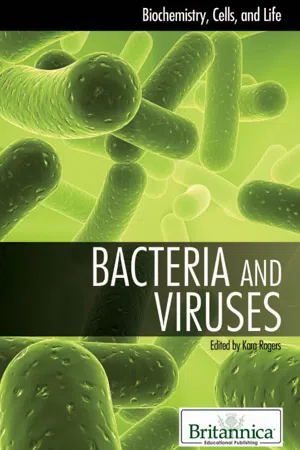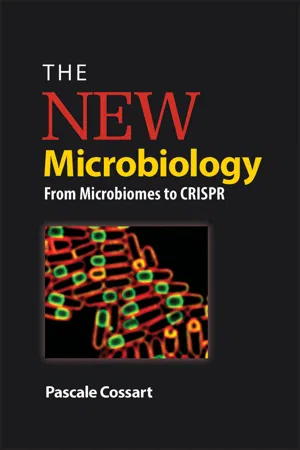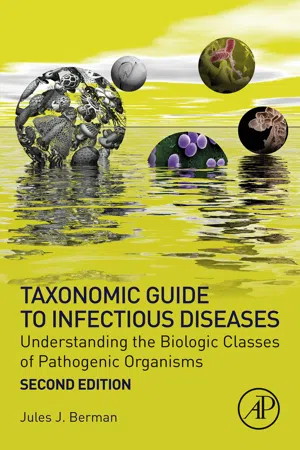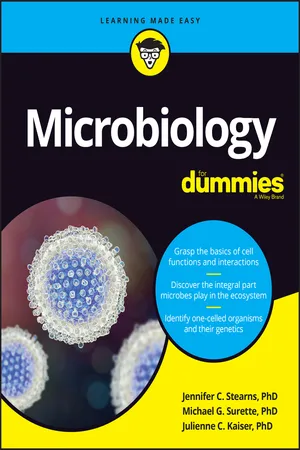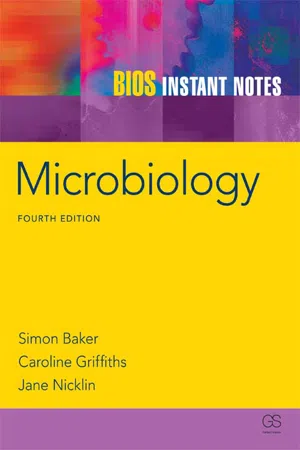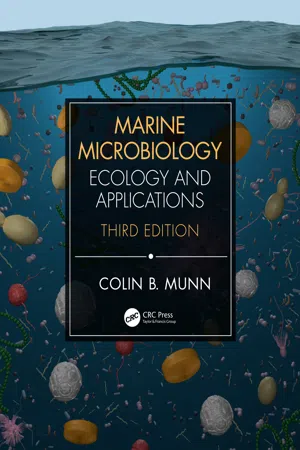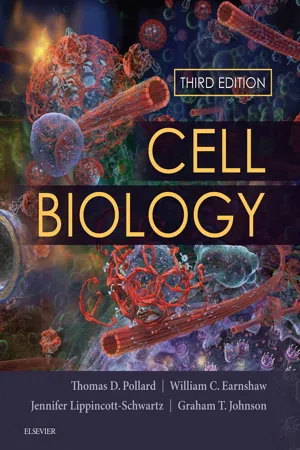Biological Sciences
Archaea vs Bacteria
Archaea and Bacteria are two distinct domains of single-celled microorganisms. While both are prokaryotes and share some similarities, they differ in genetic makeup, cell membrane structure, and metabolic processes. Archaea are known for thriving in extreme environments, such as hot springs and deep-sea hydrothermal vents, while Bacteria are more widespread and can be found in various habitats, including soil, water, and living organisms.
Written by Perlego with AI-assistance
7 Key excerpts on "Archaea vs Bacteria"
Learn about this page
Index pages curate the most relevant extracts from our library of academic textbooks. They’ve been created using an in-house natural language model (NLM), each adding context and meaning to key research topics.
- eBook - ePub
- Britannica Educational Publishing, Kara Rogers(Authors)
- 2010(Publication Date)
- Britannica Educational Publishing(Publisher)
archaea (the archaea being distinctly different from bacteria), but Woese’s splitting of the prokaryotes into two groups has remained, and all living organisms are now considered by many biologists to fall into one of three great domains: Archaea, Bacteria, and Eukarya. Further molecular analysis has shown that domain Archaea consists of two major subdivisions, the Crenarchaeota and the Euryarchaeota, and two minor ancient lineages, the Korarchaeota and the Nanoarchaeota.Archaea are found in a diverse range of extreme environments, including the salt deposits on the shores of the Dead Sea . Z. Radovan, JerusalemHABITATS OF THE ARCHAEAArchaea are microorganisms that define the limits of life on Earth. They were originally discovered and described in extreme environments, such as hydrothermal vents and terrestrial hot springs. They were also found in a diverse range of highly saline, acidic, and anaerobic environments.Although many of the cultured archaea are extremophiles, these organisms in their respective extreme habitats represent only a minority of the total diversity of the Archaea domain. The majority of archaea cannot be cultured within the laboratory setting, and their ubiquitous presence in global habitats has been realized through the use of culture-independent techniques. One commonly used culture-independent technique is the isolation and analysis of nucleic acids (i.e., DNA and RNA) directly from an environment, rather than the analysis of cultured samples isolated from the same environment. Culture-independent studies have shown that archaea are abundant and fulfill important ecological roles in cold and temperate ecosystems. Uncultivated organisms in the subdivision Crenarchaeota are postulated to be the most abundant ammonia-oxidizing organisms in soils and to account for a large proportion (roughly 20 percent) of the microorganisms present in the picoplankton in the world’s oceans. In the subdivision Euryarchaeota, uncultivated organisms in deep-sea marine sediments are responsible for the removal of methane, a potent greenhouse gas, via anaerobic oxidation of methane stored in these sediments. In contrast, uncultivated methanogenic (methane-producing) euryarchaea from terrestrial anaerobic environments, such as rice fields, are estimated to generate approximately 10–25 percent of global methane emissions. - eBook - ePub
The New Microbiology
From Microbiomes to CRISPR
- Pascale Cossart(Author)
- 2018(Publication Date)
- ASM Press(Publisher)
PART I New Concepts in MicrobiologyPassage contains an image
CHAPTER 1 Bacteria: Many Friends, Few Enemies
Bacteria are unicellular living organisms that make up one of the three domains of life: Bacteria, Archaea, and Eukaryota (Fig. 1 ). This model of three branches stemming from a common ancestor was first proposed by Carl Wo-ese in 1977. The absence of a nucleus is one major difference between prokaryotes and eukaryotes. Eukaryota or eukaryotes include animals, plants, fungi, and protozoa, which all have nuclei; bacteria and archaea are prokaryotes and do not have a nucleus. The DNA of prokaryotes is non-membrane bound, unlike in eukaryotes. But do not assume that bacteria are merely small sacks full of disorderly contents. Their “interior” is in fact very well organized.Archaea, like bacteria, are unicellular organisms but differ from bacteria in that they have lipids that are not found in bacteria and an ensemble of compounds that are similar to those of eukaryotes, in particular the machinery that regulates gene expression. When they were discovered, archaea were thought to exist only in extreme environments, such as very hot water springs, but we now know that they are present everywhere, including in our gut.Figure 1.The three large domains of life. Bacteria, Archaea, and Eukaryota have a common ancestor.Bacteria are extremely varied and make up the most diverse domain of life. They have been on Earth for billions of years and have evolved to survive in a great variety of conditions. There are more than 11,500 known species of bacteria in more than 2,000 genera (groupings of species). These numbers have so far been based only on gene comparisons, particularly the 16S RNA genes, and they keep rising. Classification methods are changing too. Now that we can compare entire genome sequences, the definition of “species” itself is evolving.Bacteria may have different shapes (Fig. 2 ). There are four main categories: cocci, or spheres; bacilli, or rods; spirals; and comma-shaped, or curved bacteria. All bacteria divide, regardless of their shape. One bacterium splits into two, via an asexual reproduction. Nevertheless, genetic material can be exchanged between two bacteria by means of mechanisms described as horizontal gene transfer - eBook - ePub
Taxonomic Guide to Infectious Diseases
Understanding the Biologic Classes of Pathogenic Organisms
- Jules J. Berman(Author)
- 2019(Publication Date)
- Academic Press(Publisher)
To understand the classification of bacteria, let us look at the controversy at the root of the tree of life. Three major groups of organisms account for all life on earth: bacteria, archaea, and eukaryotes. When you compare species of Class Bacteria with species of Class Archaea, you're not likely to notice any big differences. The bacteria have the same shapes and sizes as the archaea. All species of bacteria and all species of archaea are single-celled organisms, and they all have a typical prokaryotic structure (i.e., lacking a membrane-bound nucleus to compartmentalize their genetic material). As it happens, Class Bacteria contains all of the prokaryotic organisms (i.e., cellular organisms lacking a nucleus) that are known to be pathogenic to humans. The archaeans are nonpathogenic; many are extremophiles, capable of living in hostile environments (e.g., hot springs, salt lakes), but some archaean species can occupy less demanding biological niches (e.g., marshland, soil, human colon). Class Archaea does not hold a monopoly on extremophilic prokaryotes; some members of Class Bacteria live in extreme environments (e.g., the alkaliphilic Bacillus halodurans). The third major class of organisms, the Eukaryotes, is distinguished by the presence of a membrane-bound nucleus.For decades, archaean species were considered just another class of bacteria. This changed in 1977. Woese and Fox had been studying ribosomal RNA. Because ribosomal RNA is a fundamental constituent of all cellular organisms, sequence comparisons in the genes coding for ribosomal RNA are considered a reliable way to estimate the degree of relatedness among organisms. In 1977, Woese and Fox surprised biologists when they demonstrated profound differences in the sequence of ribosomal RNA that distinguished archaean species from bacteria [1] . Much more shocking was their finding that the sequence of archaean ribosomal RNA was more closely related to eukaryotic cells than to other bacterial cells. Other sources have since shown that the archaeans share with the eukaryotes a variety of features that are lacking in the bacteria. These include the presence of histones in some archaeans, the manner in which DNA is replicated and organized, and the finding that archaeans and eukaryotes employ several similar transcription factors (proteins that bind to DNA and control the transcription of DNA to RNA) [2] . Woese and Fox proposed that the archaeans (then called archaebacteria) comprised a kingdom, separate but equal to the bacteria. That paper, and the many contributions of Woese and colleagues that followed, sharpened our understanding of terrestrial biology and sparked a controversy that shook the foundations of taxonomic orthodoxy [3 , 4] [Glossary Molecular clock , Taxonomic order - eBook - ePub
- Jennifer Stearns, Michael Surette(Authors)
- 2019(Publication Date)
- For Dummies(Publisher)
Prokaryote is sort of a misnomer because it’s used to talk about all non-nucleated cells, as opposed to eukaryotes, which have a nucleus and organelles, among other things. Both the Bacteria and the Archaea fall into this category, but they’re more distantly related to one another than are the Archaea and the Eukaryota (the third major domain of life) and so they technically shouldn’t be grouped together. Because the Bacteria and the Archaea have many other similarities, it’s simply more convenient to consider them at the same time in this book. However, archaea and bacteria are fundamentally different from one another in terms of cellular structures and genes, including those used to determine ancestry.Making sense of the vast numbers of different species and lifestyles is no easy task. In truth, scientists will be working for many years and there still won’t be a tidy sorted list. With this in mind, we’ve put together a chapter describing the major differences between the different prokaryotes based roughly on how they’re related to one another and how they live.Another term for how things are related to one another in the evolutionary sense is phylogeny. Phylogeny is measured by comparing the genetic code in each organism. There are several ways to do this, which are summarized in Chapter 11 .There are three domains of life: Bacteria, Archaea, and Eukarya, and within each are several phyla . A phylum is a major evolutionary division that is then divided again as class, then order, then family, then genus, then species. This type of organization is called taxonomic classification and each of these divisions is called a taxonomic rank .Kingdom used to be the highest taxonomic rank until recently when the higher rank of domain was added. Kingdom is still an important rank when describing major groups within the domain Eukarya, but it’s less useful for describing the Bacteria and the Archaea domains. For this reason, kingdom isn’t used in this chapter.Getting to Know the Bacteria
Of the two domains of prokaryotes, the Bacteria are the best studied and contain all known prokaryotic pathogens. In reality, only about 1 percent of all bacteria have been studied in any detail and of these only a small proportion cause disease. Some, like Pseudomonas, take the opportunity to colonize humans when their immune system is down, but they aren’t primarily human pathogens thriving mainly as free-living bacteria in soils. Others, like Wolbachia and Mycoplasma, lack a cell wall and cannot live outside a host cell. Figure 12-1 - eBook - ePub
- Simon Baker, Jane Nicklin, Caroline Griffiths(Authors)
- 2011(Publication Date)
- Taylor & Francis(Publisher)
Thermophiles, halophiles, and other extremophilic Archaea are well known, but this kingdom also includes many mesophiles. It is becoming apparent that there is a similar or even greater physiological and biochemical diversity in the Archaea compared with the Bacteria. The phylum CrenarchaeotaMost crenarchaeotes cultured in the laboratory are extremophiles capable of growth above 80°C. The best known examples are Sulfolobus solfataricus and Pyrodictium abyssi, the latter holding the current record for biological growth at high temperature (110°C). The morphology of Pyrodictium spp. is unusual, with disk-shaped cells interconnected by hollow tubes of unknown function (cannulae). The phylum EuryarchaeotaThis phylum of the Archaea includes both mesophiles and extremophiles, most notable among which are the methanogens and Pyrococcus furiosus. The phylum KorarchaeotaSeveral phyla in both the Archaea and the Bacteria have been proposed on the basis of the existence of environmental 16S rRNA sequences. The Korarchaeota have been identified in this way, despite claims that the signature sequences were artifacts. A member of the phylum has now been cultured and its genome sequenced.The prokaryotesRelated topics (B1 ) Prokaryotic systematics(B2 ) Identification of Bacteria(B3 ) Inference of phylogeny fromrRNA gene sequence(C7 ) Composition of a typical prokaryotic cell (C9 ) Cell division(C10 ) Bacterial flagella and movement(C11 ) Prokaryotes and their environment The prokaryotes consist of many thousands of known species, to which some order has been applied with the advent of 16S rRNA sequencing. The resulting phylogenetic tree (Figure 1 - eBook - ePub
Marine Microbiology
Ecology & Applications
- Colin Munn, Colin B. Munn(Authors)
- 2019(Publication Date)
- CRC Press(Publisher)
The discovery that Archaea are a major component of ocean microbiota ranks as one of the most significant surprises to emerge from the application of methods to directly sequence 16S rRNA isolated from planktonic biomass (see p.42). The first clues came in 1992, when Jed Fuhrman (University of Southern California) and Ed De Long (then at Woods Hole Oceanographic Institution) independently discovered archaeal sequences in seawater samples. Fuhrman et al. (1992) found sequences in pelagic water samples from the Pacific Ocean (100 and 500 m depth) that were only distantly related to those of any organisms previously characterized. The closest match for some of these sequences was to extreme thermophiles, which had been assigned to the new domain Archaea (at that time, often still referred to as archaebacteria). DeLong (1992) also discovered widespread archaeal rRNA sequences in coastal surface waters off the east and west coasts of North America. Before these discoveries, it was assumed that Archaea are only found in extreme environments, inhospitable to other life forms. Within a few years, numerous studies had established these currently uncultivated Archaea are highly abundant in surface and deep surface waters in all the major ocean basins.Several aspects of cell structure and function distinguish the Archaea and Bacteria
While the basic organization of the cells of bacteria and archaea is similar, there are some important structural and physiological differences. Indeed, some aspects of archaeal biology show closer similarities to those of the Eukarya than they do to the Bacteria, the significance of which will become clear when we consider their possible evolutionary relationships. As described in Chapter 3, there are major differences between bacterial and archaeal cell membranes, which contain fatty acid-based lipids and isoprenoid-based lipids, respectively. However, analysis of gene sequences has blurred this distinction; some of the recently discovered uncultivated bacterial taxa in the Candidate Phyla Radiation (Figure 4.1 - eBook - ePub
- Thomas D. Pollard, William C. Earnshaw, Jennifer Lippincott-Schwartz, Graham Johnson(Authors)
- 2016(Publication Date)
- Elsevier(Publisher)
Nature. 2015;521:173–179.)Abetted by rapid proliferation and large populations, natural selection allowed prokaryotes to explore many biochemical solutions to life on the earth. Some Bacteria and Archaea (and some eukaryotes too) thrive under inhospitable conditions, such as anoxia and temperatures greater than 100°C as found in deep-sea hydrothermal vents. Other Bacteria and Archaea can use energy sources such as hydrogen, sulfate, or methane that are useless to eukaryotes. Far less than 1% of Bacteria and Archaea have been grown successfully in the laboratory, so many varieties escaped detection by traditional means. Today, sequencing DNA samples from natural environments has revealed vast numbers of new species in the ocean, soil, human intestines, and elsewhere. Only a very small proportion of bacterial species and no Archaea cause human disease.Chlorophyll-based photosynthesis originated in Bacteria around 3 billion years ago. Surely this was one of the most remarkable events during the evolution of life on the earth, because photosynthetic reaction centers (see Fig. 19.8 ) require not only genes for several transmembrane proteins, but also genes for multiple enzymes, to synthesize chlorophyll and other complex organic molecules associated with the proteins. Chapter 19 describes the machinery and mechanisms of photosynthesis.Even more remarkably, photosynthesis was invented twice in different bacteria. A progenitor of green sulfur bacteria and heliobacteria developed photosystem I, while a progenitor of purple bacteria and green filamentous bacteria developed photosystem II. Approximately 3 billion years ago, a momentous lateral transfer event brought the genes for the two photosystems together in cyanobacteria, arguably the most important organisms in the history of the earth. Cyanobacteria (formerly misnamed blue-green algae ) use an enzyme containing manganese to split water into oxygen, electrons, and protons. Sunlight energizes photosystem II and photosystem I to pump the protons out of the cell, creating a proton gradient that is used to synthesize ATP (see Chapters 14 and 19
